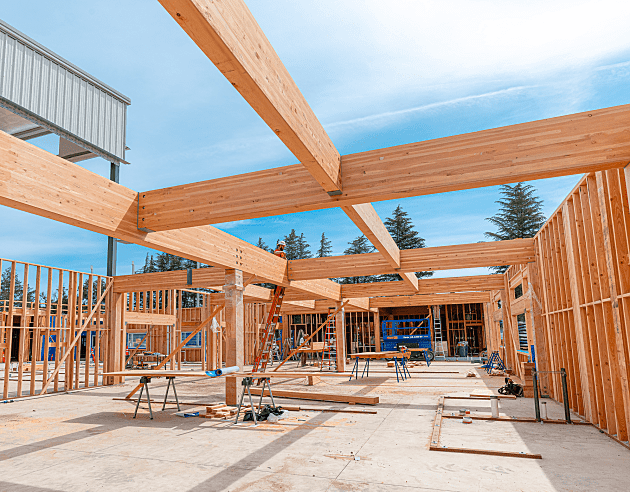- Project uploaded by WoodWorks Innovation Network (WIN) on 08-24-2023
- Project last updated by WoodWorks Innovation Network (WIN) on 06-10-2024
Forest History Society
Durham, NCThe project is a new Headquarters Building for the Forest History Society, a nonprofit with a growing research library and archives collections. The Forest History Society is the preeminent organization supporting research and understanding of how people used and interacted with the forested ecosystems of the planet over the long sweep of human history.
The facility was designed to promote the current and future staff, research, public outreach and archive functions. The design features North American wood products throughout the facility. The design aesthetic combines vernacular gable forms with clean modern panel system, which reflects the Society's history and its future.
"We honor the history of forests, forestry and conservation by placing the Society's new home carefully in the forest and showcasing forest products throughout the building."
The new site for the headquarters was an original part of Duke Forest near the Duke University campus. The building was placed on an existing ridge on an east - west axis to maximize daylighting and minimize solar heat gain. A curvelinear entry drive and small parking area minimized the clearing needed along with preserving specimen hardwood trees along the entry drive.
The remaining forest was inventoried by Duke forestry students and trails were created that feature other specimen hardwood trees on the site. The building plan was organized by intersecting wings with exposed wood glulam structure defining the major public spaces of the facility. The main entrance leads to a north - south linear transparent space that features the lobby reception area and an exhibit hall that will house changing exhibits featuring the work of the Society. This space leads to the research library featuring research zones at the center at each end of an intersecting east - west wing that have views into the surrounding forest. A private reading area defined by donated glass panels terminates the north - south axis.
The other two main functions of the building are placed in another intersecting east - west wing near the main entry. The archives space occupies the east end of the wing and features a special humidity control and chemical fire suppression system. The archives space has a loading dock and adjacent prep and digital media processing areas. A multipurpose meeting area occupies the west end of the axis. The meeting space was designed to accommodate multiple types of meetings, presentations and public events. The space also has views of the forest and a spill out covered exterior courtyard.
The staff spaces are clustered in the central core of the building with close proximity to the lobby, exhibit space, meeting area, library and archives. Sustainable Design + Carbon Footprint A number of sustainable design strategies were utilized on the project. These included daylighting, well insulated building envelope, highly solar reflective roof system, FSC certified wood products, recycled building materials and VRF HVAC system + LED lighting. The carbon footprint of the building was reduced by the extensive use of wood products that both store carbon and reduce greenhouse emissions due to the lower energy needed to harvest and fabricate wood products as opposed to other more energy intensive building materials.
The submittal outlines the specific carbon reduction achieved. An important design concept and challenge was the integration of all the wood products used in the project. Many of the wood products used were donated and it was also important to use various North American wood species in a sustainable way.
The primary building structure was glue laminated wood beams, columns and trusses made from southern yellow pine. The secondary structure was wood framing, and a steel structure was used at the archives to comply with federal regulations on archived items. Stonewood panels a paper and resin composite product were used as a rain screen over most of the facades. A redwood trellis infills the 5 exterior gables overhangs at the end of each wing. The trellis helps shade the large windows below the gables. Aluminum clad windows featuring ponderosa pine are the primary exterior punched windows. The building interior finishes were organized by 3 wood species all donated by various suppliers. The main entry and exhibit hall space feature white oak wood floors, trim and wall panels. The library features red oak wood floors and trim. The multipurpose space features maple wood floors, trim and wall panels.
Project Details
-
Year Built
2018
-
Number Of Stories
1
-
Bldg system
Innovative Light-Frame
-
Square footage
20,000
-
Construction Type:
V-B
-
Building Type:
Educational
-
Material Types:
Glue-Laminated Timber (GLT or glulam)
Hybrid (wood with steel or concrete)
Light-Frame
Project Team
-
CJT PA Civil Engineers + Landscape Architects
-
CT Wilson Construction Co. General Contractor
-
DTW Architects + Planners Architect
-
Edmondson Engineers Fire Protection Engineer
-
Forest History Society Developer
-
Ross Linden PA Structural Engineer
- Project uploaded by WoodWorks Innovation Network (WIN) on 08-24-2023
- Project last updated by WoodWorks Innovation Network (WIN) on 06-10-2024



 WOODWORKS
INNOVATION
NETWORK
WOODWORKS
INNOVATION
NETWORK




